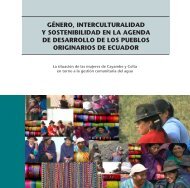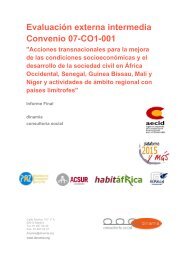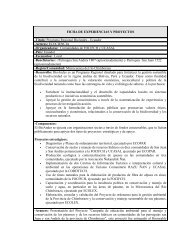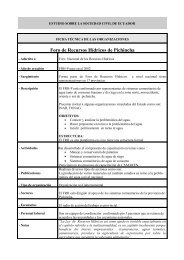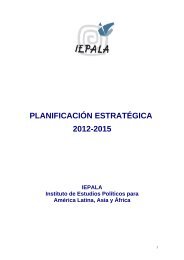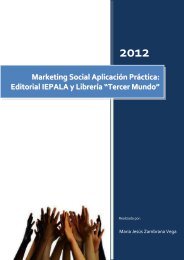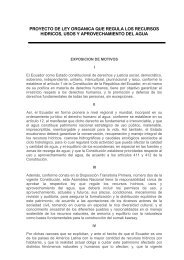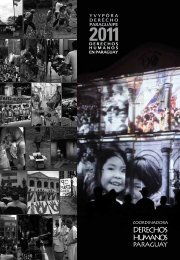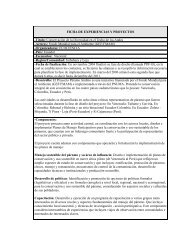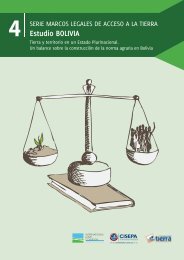Decentralization in Sierra Leone - Research for Development
Decentralization in Sierra Leone - Research for Development
Decentralization in Sierra Leone - Research for Development
You also want an ePaper? Increase the reach of your titles
YUMPU automatically turns print PDFs into web optimized ePapers that Google loves.
<strong>Decentralization</strong> <strong>in</strong> <strong>Sierra</strong> <strong>Leone</strong>Data obta<strong>in</strong>ed from the CCFC <strong>in</strong> Magburaka showed that the gross amount of local taxcollected <strong>in</strong> Tonkolili District <strong>in</strong> 2008 was 315.2 million <strong>Leone</strong>s, up from 146.2 million <strong>in</strong>2006 and 96.6 million <strong>in</strong> 2007. Even with the highest figure, the average amount of tax (notcount<strong>in</strong>g revenues from market dues and store licences) raised <strong>in</strong> each of the elevenchiefdoms of the district that year was the equivalent of 6,500 US Dollars. A 40 per centprecept would have yielded the local council the equivalent of 28,600 US Dollars, which issmall <strong>in</strong> comparison to the average grant transfer to each local council of 680,000 US Dollars<strong>in</strong> the same year. Yet the M<strong>in</strong>istry’s <strong>in</strong>tervention, and the overall lack of transparency <strong>in</strong>chiefdom f<strong>in</strong>ancial adm<strong>in</strong>istration, underm<strong>in</strong>es the development of any social contractbetween decentralized service provides and local taxpayers (Rob<strong>in</strong>son, 2010). Develop<strong>in</strong>gsuch a contract is of course fundamental to decentralization as a peacebuild<strong>in</strong>g strategy.Similar problems have emerged <strong>in</strong> respect of the chiefdom’s residual adm<strong>in</strong>istrative andservice functions. Much of the exist<strong>in</strong>g legislation on chiefdom governance (<strong>in</strong>clud<strong>in</strong>g Cap61) was orig<strong>in</strong>ally drafted <strong>in</strong> the colonial era with the aim of graft<strong>in</strong>g local governmentfunctions onto customary authority (Fenton, 1935; Kilson, 1966). This legislation grantedChiefdom Councils (then known as Tribal Authorities) the power to raise their own taxes,draw up adm<strong>in</strong>istrative budgets and hire salaried staff. In addition to their law and orderfunctions, chiefdom authorities also acquired statutory powers to issue orders to their peopleto prevent water pollution and the spread of <strong>in</strong>fectious diseases, to ensure that the sick andmentally <strong>in</strong>firm were cared <strong>for</strong> and to regulate tree cutt<strong>in</strong>g, livestock management and farmburn<strong>in</strong>g. They were further empowered to make bye-laws perta<strong>in</strong><strong>in</strong>g to: a) the sett<strong>in</strong>g aside ofland <strong>in</strong> a chiefdom <strong>for</strong> development purposes, b) the management of public services and thelevy<strong>in</strong>g of fees <strong>for</strong> these services; c) the construction of new build<strong>in</strong>gs; e) street trad<strong>in</strong>g; f) theestablishment, regulation and management of markets, slaughter houses, wash houses andcemeteries. By 1950, Chiefdom Councils were support<strong>in</strong>g (with considerable assistance fromcentral government) primary education, school scholarship schemes, agricultural extension,primary health and feeder road construction. Their staff at this time <strong>in</strong>cluded clerks,messengers (<strong>for</strong>erunners of the Chiefdom Police) agricultural overseers, <strong>for</strong>est wardens,sanitary <strong>in</strong>spectors, dispensers, midwives and labourers (Davidson, 1953).Parallel ef<strong>for</strong>ts were made to ensure that chiefdom govern<strong>in</strong>g bodies were representative ofthe chiefdom people. The orig<strong>in</strong>al statutory def<strong>in</strong>ition of a chiefdom authority was the“Paramount Chief, the Chiefs, the councillors and men of note elected by the peopleaccord<strong>in</strong>g to native law and custom, approved by the Governor and appo<strong>in</strong>ted a TribalAuthority under the Ord<strong>in</strong>ance <strong>for</strong> the area concerned” (Tribal Authorities Ord<strong>in</strong>ance, No. 8of 1937). Attempts were soon made to expand these bodies to <strong>in</strong>clude elected representativesof taxpayers. The 1:20 ratio of councillors to taxpayers was fixed by government decree <strong>in</strong>1956 (Kilson, 1966). Most Chiefdom Councils subsequently became too large to functioneffectively as deliberative <strong>for</strong>ums, prompt<strong>in</strong>g statutory recognition of a Chiefdom Committeeto serve as the executive arm of the Chiefdom Council. The Tribal Authorities (Amendment)Act of 1964 states that the Chiefdom Committee should comprise of the Paramount Chief(Chairman), senior Speaker (Vice-Chairman), the second Speaker (if any), Treasury Clerk(Secretary) two members from each electoral ward <strong>in</strong> the chiefdom elected by the chiefdomcouncillors, and a literate councillor nom<strong>in</strong>ated by the local government M<strong>in</strong>ister. ManyChiefdom Committees went on to appo<strong>in</strong>t youth leaders and Women’s leaders (MammyQueens), although these last two positions have never been recognized <strong>in</strong> law.The primary functions of the Chiefdom Committee, accord<strong>in</strong>g to the 1964 Act, are: a) toprepare chiefdom budgets and <strong>in</strong>spect chiefdom accounts on a regular basis; b) negotiateFanthorpe Consultancy Ltd Page 58




